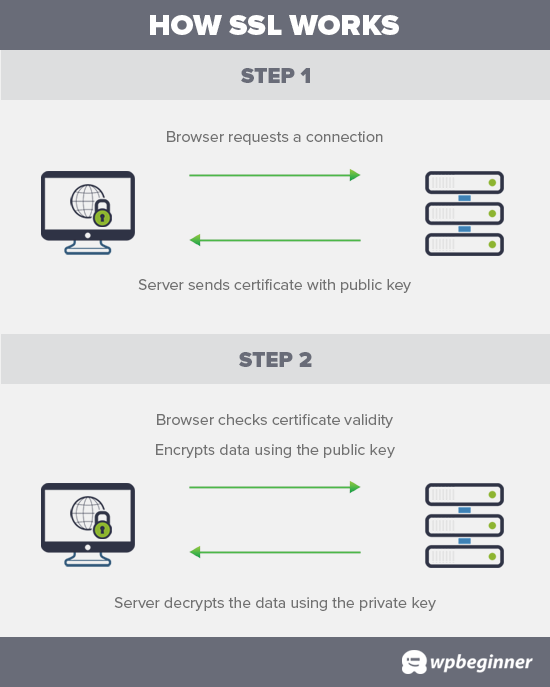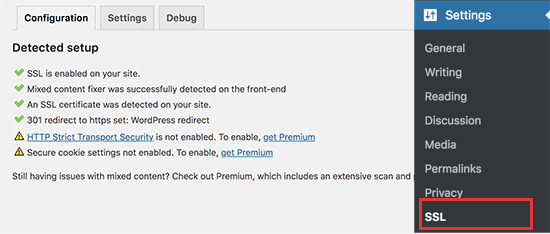SSL is an abbreviation used for Secure Sockets Layers, an encryption technology that keeps sensitive data between web servers and web browsers secure and private.
SSL may also be called TLS or Transport Layer Security protocol. These protocols rely on certificates that provide an assurance to the user about the identity of the website they are communicating with.
Once you enable SSL, your website will use HTTPS instead of HTTP, and you will also see a padlock sign next to your website address in the browser to show that it is secure.

Should I Use SSL on My Website?
We recommend that all WordPress websites use SSL. It’s one of the best practices listed in our ultimate security guide.
You should be aware that Google Chrome and other web browsers show non-SSL websites as ‘Not Secure’. This means that if you are not using an SSL certificate on your website, then you can lose your customers’ trust.
As a website visitor, you should proceed with extreme caution on websites that have a ‘Not Secure’ label. We recommend that you don’t give them any personal information.
Sites that use SSL will display a padlock icon in the address bar. Users can click on this icon to view certification, identification and other information about a website.
Websites requiring personal data must have an active SSL certificate installed from a recognized Certificate Authority (CA). That includes WordPress users operating an eCommerce site, membership site, or any type of website that requires a user to either submit a payment or login information.
How Does SSL Work?
SSL protects user information by encrypting the data being exchanged between the web server and a visitor’s browser.
When visiting a website, your browser will automatically check for an SSL certificate and to see if it is valid and up to date.
If a website’s certificate is correct, then the browser then uses the website’s public key to encrypt the data. They then send this data back to the designated website’s server where it is decrypted using both the public key and a secret private key.

If the certificate is not correct, then users will be warned that the connection is not private. It is important that site owners fix this error as soon as possible so that they don’t lose traffic.
How to Get an SSL Certificate for Your Website
Most of the best WordPress hosting companies are now offering their users free SSL certificates. If your hosting provider does not offer an SSL certificate, then we recommend using Domain.com to purchase an SSL certificate.
Domain.com is among the largest domain registration services in the world, and they offer the most affordable SSL prices. Their SSL certificates come with a $10,000 security warranty and a TrustLogo seal.
If you are just starting a blog or making a DIY business website, then you likely want to keep costs low. Luckily, there are multiple ways to get a free SSL certificate and you can learn how in our beginner’s guide on how to get a free SSL certificate for your WordPress website.
How to Install SSL on WordPress
Once you have purchased an SSL certificate, you will have to enable the certificate on your domain name. Then, you’ll need to set up your WordPress website to use SSL and HTTPS protocols. You’ll also need to let Google know you are now using SSL to avoid any SEO issues.
In our beginner’s guide on how to properly move WordPress from HTTP to HTTPS, we show you two methods to set up SSL on your website, including one that is easier for beginners. Alternatively, you can ask your hosting provider to install the SSL certificate for you.

Moving a WordPress site to SSL can sometimes result in unexpected issues. If you’re adding SSL to an existing WordPress site and are running into errors, then check our guide on how to fix common SSL issues in WordPress.
We hope this article helped you learn more about SSL in WordPress. You may also want to see our Additional Reading list below for related articles on useful WordPress tips, tricks, and ideas.
If you liked this guide, then please consider subscribing to our YouTube Channel for WordPress video tutorials. You can also find us on Twitter and Facebook.
Additional Reading
- How to Secure your WordPress Pages with SSL
- How to Get a Free SSL Certificate for Your WordPress Website (Beginner’s Guide)
- How to Properly Move WordPress from HTTP to HTTPS (Beginner’s Guide)
- How to Fix Common SSL Issues in WordPress (Beginner’s Guide)
- How to Fix Your Connection is Not Private Error (Site Owners Guide)



